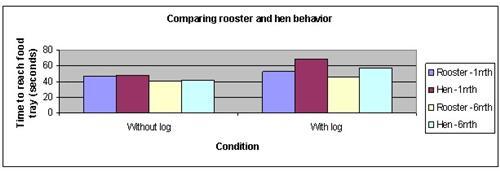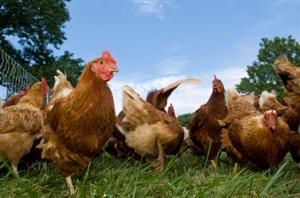| Complexity level: | 3 |
| Project cost ($): | 30 |
| Time required: | It will take a day to set up the experiment, and 2 days for observation |
| Material availability: | The chickens can be purchased from a feed store or hatchery |
| Safety concerns: | Adult supervision is required when handling live fowl. |
Hypothesis
The roosters will get to the feeding tray feeder than the hens.
Overview
Chicken
Chickens are domesticated fowl; they are bred in farms for their meat and eggs. They are omnivores: they feed on seeds, worms and insects found in the soil. Sometimes, they feed on larger animals such as small mice and lizards. The male chicken is called a ‘rooster’ and the female chicken is called a ‘hen’. Baby chickens are called ‘chicks’.
Roosters have large red combs, and these differentiate them from hens. They also have longer tails, and pointed and shiny feathers at the neck and back. Roosters usually perch on a fence or on high ground, crowing early in the day. They do this to proclaim their territory. They also sit on a perch in order to look after their flock; they warn the hens when danger approaches.
Normally, hens lay eggs and look after chicks. They tend to lay their eggs in the same location or a few favorite locations. Hens do not know if their eggs have been fertilized. Thus, they sit on the eggs for 3 weeks. If the eggs hatch, the hens busy themselves with looking after their chicks. Otherwise, they will abandon their eggs, leaving them to rot.
Scientific Terms
Materials
The materials required for the experiment are as follows:
- Three 1 month old roosters
- Three 1 month hold hens
- Three 6 months old roosters
- Three 6 months old hens
- a bag of chicken feed
- an area that is fenced
- a feeding tray
- a log that is 3meters long and 0.3 meters thick
- 2 chicken cages
- an assistant
- a stop watch
Procedure
1. For this experiment, the independent variables are the chickens’ age and gender. The dependent variable is the amount of time the chickens take to reach their food. Use a stopwatch to time them. The constant (control variable) are the distance between the cage and the chicken feed.
2. Use roosters and hens of 2 age groups: 1 month and 6 months. There should be 3 chickens from each age group. Fence an area that is 3m wide and 5m long. House the 12 chickens in 2 cages, according to their age. No food should be given to them 12h before the experiment.
3. Test the 1 month old chickens first. Place the cage 4meters from a food tray filled with chicken feed. Time how long it takes for the chickens to reach the tray once the cage is opened. Calculate the average amount of time the 3 roosters and 3 hens take, and record this in the table below. Repeat the test with the 6 month old chickens.
4. Repeat procedure number 3 the next day, but this time, first place a log between the cage and the tray.

Results
It is observed that in the test without the obstacle, both the roosters and hen reached the food tray at almost the same time. When tested with a log as an obstacle, the roosters were faster in reaching the food tray than the hens. The 6 month old roosters and hens were also faster than the 1 month old chickens.
| Condition | Average amount of time the chickens take (seconds) | |||
| Rooster -1mth | Hen -1mth | Rooster -6mth | Hen -6mth | |
| Without log | 46 | 48 | 41 | 42 |
| With log | 52 | 68 | 45 | 57 |
Use the graph below to plot your results.

Conclusion
The hypothesis holds true: the roosters reached the feeding tray sooner than the hens.
The domestication of chickens first occurred in India. Persians followed suit, and so did the rest of the world. Chickens are reared for their meat and eggs. Chicken meat is cheaper than other meats. Hence, it is consumed more than any other kind of meat..
Also consider
Use ducks or turkeys instead of chickens.
The experiment can also be repeated to compare chickens of different ages.
References
Chicken - http://en.wikipedia.org/wiki/Chicken
Rooster - http://en.wikipedia.org/wiki/Rooster
Chicken behavior - http://www.gallosuisse.ch/html/index.php?id=13&L=1

